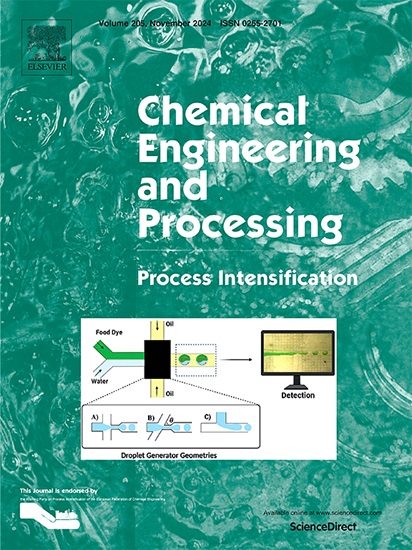Evaluating the performance of batch, tubular coiled and coil flow invertor reactors in biodiesel production from karanja and used cooking oil
IF 3.8
3区 工程技术
Q3 ENERGY & FUELS
Chemical Engineering and Processing - Process Intensification
Pub Date : 2025-05-23
DOI:10.1016/j.cep.2025.110375
引用次数: 0
Abstract
Current research evaluates the performance of three different contacting schemes: the batch reactor, tubular coiled reactor (TCR), and coiled flow inverter (CFI). Experiments utilized a 1.5 wt. % KOH catalyst with varying methanol/oil molar ratios in both batch and continuous reactors. The TCR and CFI were tested at a 9:1 methanol/oil molar ratio with flow rates ranging from 2–10 ml/min, using Karanja oil and Used Cooking Oil. Notably, the biodiesel produced in this study met the key fuel property requirements such as kinematic viscosity, density, flash point, and calorific value according to the American Society for Testing and Materials (ASTM) biodiesel standards. The highest biodiesel yield in the batch reactor was 90.63 % at 900 RPM. The continuous flow reactors achieved an 82.52 % yield in the TCR with a diameter of 1.65 mm and a length of 4 m, and a 92.6 % yield in the U-shaped CFI at a flow rate of 8 ml/min. Notably, the highest yield for Karanja oil and used cooking oil was observed in the CFI (U-shape) compared to the TCR, CFI (L-shape), and batch reactor. This study showed an improvement in biodiesel properties by using two-stage esterification-transesterification methods.

评价间歇式反应器、管状盘管式反应器和盘管流式反应器在用karanja和废食用油生产生物柴油中的性能
目前研究评估了三种不同的接触方案:间歇式反应器、管状盘管反应器(TCR)和盘管流动逆变器(CFI)的性能。实验使用1.5 wt. %的KOH催化剂,在间歇反应器和连续反应器中使用不同的甲醇/油摩尔比。在甲醇/油摩尔比为9:1,流量为2-10 ml/min的条件下,使用Karanja油和废油对TCR和CFI进行测试。值得注意的是,本研究中生产的生物柴油符合美国材料试验协会(ASTM)生物柴油标准的关键燃料性能要求,如运动粘度、密度、闪点和热值。间歇式反应器在900 RPM转速下的生物柴油收率最高可达90.63%。在直径为1.65 mm、长度为4 m的TCR中,连续流反应器的产率为82.52%;在流量为8 ml/min的u型CFI中,连续流反应器的产率为92.6%。值得注意的是,与TCR、CFI (l形)和间歇式反应器相比,在CFI (u形)中观察到Karanja油和废食用油的最高收率。本研究表明,采用两级酯化-酯交换法可改善生物柴油的性能。
本文章由计算机程序翻译,如有差异,请以英文原文为准。
求助全文
约1分钟内获得全文
求助全文
来源期刊
CiteScore
7.80
自引率
9.30%
发文量
408
审稿时长
49 days
期刊介绍:
Chemical Engineering and Processing: Process Intensification is intended for practicing researchers in industry and academia, working in the field of Process Engineering and related to the subject of Process Intensification.Articles published in the Journal demonstrate how novel discoveries, developments and theories in the field of Process Engineering and in particular Process Intensification may be used for analysis and design of innovative equipment and processing methods with substantially improved sustainability, efficiency and environmental performance.

 求助内容:
求助内容: 应助结果提醒方式:
应助结果提醒方式:


